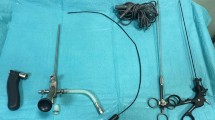Abstract
Background
The aim of this study was to investigate whether the addition of laser to the endoscopic pilonidal sinus treatment (EPSIT), laser-assisted EPSIT (LEPSIT) has an effect on the method and clinical results in the treatment of pilonidal sinus disease (PSD).
Methods
Between September 2019 and September 2020, patients who underwent LEPSIT and EPSIT procedures for PSD at Bursa Medicana Hospital, Turkey, were matched for age, pit location and number, body mass index (BMI), and sex. The primary endpoint was complete wound healing and the secondary endpoints were quality of life, cosmetic results, and cost.
Results
Twenty-four LEPSIT patients were matched to 72 EPSIT patients. Eighty-one (84.4%) of the included patients were male, and the median age was 26 years (range 16–52 years). The median follow-up time was 9 months (range 3–15 months).Wound healing rates (LEPSIT; 95.8% vs. EPSIT; 93%; p = 0.99) were similar in both groups. In patients who underwent LEPSIT, the operative time (p = 0.00086) was significantly shorter, time taken to return to work (p = 0.03572) and wound closure (p < 0.00001) were significantly less. However, the time taken to return to daily activities and the percentage of wound complications were similar in both groups. The pain scores on postoperative -days 1 7, and 14 were significantly higher after EPSIT (p = 0.0083, p = 0.00054, and p = 0.0479, respectively). The postoperative analgesic requirement was significantly higher after EPSIT (p = 0.01492). The total hospital cost was significantly less in patients who underwent EPSIT (p < 0.00001). Significantly better cosmetic improvement was observed in LEPSIT procedure (p = 0.00694). First month quality of life (evaluated with the Short Form 36 Health Survey Questionnaire) was similar except for bodily pain (better after LEPSIT).
Conclusions
The success rates of LEPSIT and EPSIT are similar. LEPSIT results in better wound healing and patient comfort, and a shorter time to return to work.



Similar content being viewed by others
References
Meinero P, Stazi A, Carbone A et al (2016) Endoscopic pilonidal sinus treatment: a prospective multicentre trial. Color Dis 18:164–170
Tien T, Athem R, Arulampalam T (2018) Outcomes of endoscopic pilonidal sinus treatment (EPSiT): a systematic review. Tech Coloproctol 22:325–331
Meinero P, La Torre M, Lisi G et al (2019) Endoscopic pilonidal sinus treatment (EPSiT) in recurrent pilonidal disease: a prospective international multicenter study. Int J Colorectal Dis 34:741–746
Pappas AF, Christodoulou DK (2018) A new minimally invasive treatment of pilonidal sinus disease with the use of a diode laser: a prospective large series of patients. Colorectal Dis 20:0207–0214
Dessily M, Dziubeck M, Chahidi E et al (2019) The SiLaC procedure for pilonidal sinus disease: long-term outcomes of a single institution prospective study. Tech Coloproctol 23:1133–1140
Dessily M, Charara F, Ralea S et al (2017) Pilonidal sinus destruction with a radial laser probe: technique and first Belgian experience. Acta Chir Belg 117:164–168
Oztürk E, Gülcü B (2014) Laser ablation of fistula tract: a sphincter preserving method for treating fistula-in-ano. Dis Colon Rectum 57:360–364
Kayaalp C, Aydin C (2009) Review of phenol treatment in sacrococcygeal pilonidal disease. Tech Coloproctol 13:189–193
Bradley L (2010) Pilonidal sinus disease: a review. Part two. J Wound Care 19:522–530
Isik O, Gulcu B, Ozturk E (2020) Long-term outcomes of laser ablation of fistula tract for fistula-in-ano: a considerable option in sphincter preservation. Dis Colon Rectum 63:831–836
Soklaridis S, Cassidy JD, van der Velde G et al (2012) The economic cost of return to work: an employer’s perspective. Work 43:255–262
Funding
None.
Author information
Authors and Affiliations
Contributions
Study conception design: BG, EO. Data acquisition: BG. Data analysis and interpretation: BG. Drafting the article: BG. Critical revision for intellectual content: EO. Final approval of the manuscript: BG, EO.
Corresponding author
Ethics declarations
Conflict of interest
The authors declare that they have no conflict of interest.
Ethical approval
The study was conducted according to the tenets of the Declaration of Helsinki. No Institutional Review Board approval was required for this study. Since our study was retrospective, we did not receive ethical approval.
Informed consent
For this type of study, formal consent is not required.
Additional information
Publisher's Note
Springer Nature remains neutral with regard to jurisdictional claims in published maps and institutional affiliations.
Rights and permissions
About this article
Cite this article
Gulcu, B., Ozturk, E. Endoscopic pilonidal sinus treatment vs. laser-assisted endoscopic pilonidal sinus treatment: short-term results from a retrospective case-matched study. Tech Coloproctol 26, 271–277 (2022). https://doi.org/10.1007/s10151-021-02568-8
Received:
Accepted:
Published:
Issue Date:
DOI: https://doi.org/10.1007/s10151-021-02568-8




